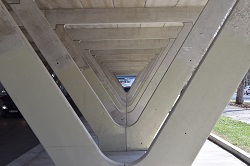Measuring the impact of concrete from cradle to grave
CLIMATCON, a project carried out at Heriot-Watt University (HWU) in Edinburgh, UK, with Marie Curie Fellow Xiao-Hui Wang as main researcher, has looked at how reinforced concrete beams carbonate when under load. It has compared the performance of conventional concrete, made with Portland cement, to that of ‘green’ concretes which contain fly ash or ground granulated blast-furnace slag, both by-products of industry. The concrete industry has a big environmental footprint — contributing about 5 % of global CO2 emissions, mainly through calcination when making cement. Green concretes, which have been around for a long time, are now growing in popularity as a way of reducing emissions. Once a reinforced concrete structure has been built, the concrete starts to slowly absorb CO2 from the atmosphere through a process of carbonation. But while this can be seen as offsetting some of the original CO2 emissions, carbonation also reduces concrete’s alkalinity making the steel inside vulnerable to corrosion. Corrosion starts earlier Green concretes are known to carbonate faster than traditional ones. ‘If you use green concretes, you reduce the carbon dioxide emissions but the rate of carbonation is higher and corrosion can start earlier,’ says Dimitri Val, project supervisor and professor of infrastructure, safety and reliability at HWU, ‘so you need to spend money to do repairs which pushes up costs and causes additional emissions.’ The CLIMATCON team set out to find a way of measuring how sustainable the different kinds of concrete really are by evaluating the environmental impact and costs over the whole life of structures. This cradle-to-grave approach improves on previous methods which had paid little attention to the effects of deterioration. Beam specimens made of six different concretes were put into a special chamber and subjected to accelerated carbonation for 120 or 240 days. ‘It is known that if concrete is loaded, its rate of carbonation is higher so we put loaded specimens in the chamber,’ says Professor Val. Surprising results Measuring the rate of carbonation produced some surprises. ‘Loading affected the rate in green concretes much more than in normal concrete and this increase was much higher than expected,’ says Professor Val. This could have consequences for how green concretes perform in real structures but more research is needed into why this occurs – ‘we need to look at what happens … at material level,’ says Professor Val. The team then produced a numerical model which can predict how fast concrete will carbonate and how much CO2 it will take up, accounting for factors including load, cracks in the concrete, temperature and humidity. The final output is a probabilistic method for evaluating the whole-life performance of reinforced concrete structures when subject to carbonation. This takes into account deterioration and the subsequent need for maintenance and repairs and allows you to predict the associated emissions of CO2 and balance this against its uptake from carbonation. By following this methodology, the first to combine both the cost and the environmental impact and account for uncertainties, civil engineers, concrete manufacturers and those in charge of setting building standards will be able to address the sustainability of concrete structures in a much more rational way, Professor Val concludes.







